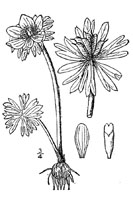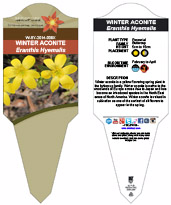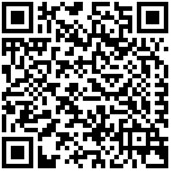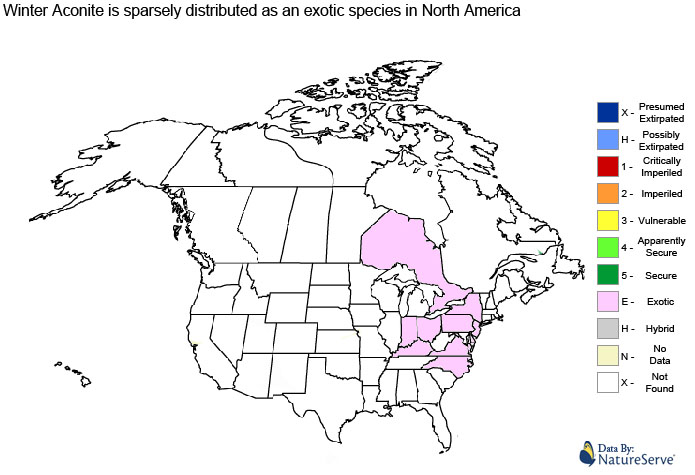Winter aconite is a yellow flowering spring plant in the buttercup family. Winter aconite is native to the woodlands of Europe across Asia to Japan and has become an introduced species in the North East areas of North America. Winter aconite is valued in cultivation as one of the earliest of all flowers to appear in the spring. The Latin name eranthis hyemalis means "winter-flowering". The common name comes from the early flowering time and the resemblance of the leaves to those of the related genus Aconitum, the true aconite.
There is currently no commercial applications for winter aconite.
Within the realm of rational and holistic medicine, there is currently no historical, or current, uses for winter aconite.
Please note that MIROFOSS does not suggest in any way that plants should be used in place of proper medical and psychological care. This information is provided here as a reference only.
Winter aconite is considered to be poisonous and should not be consumed.
Winter aconite is a tuberous rooted herbaceous perennial growing 5cm to 15cm in height with large 2cm to 3cm yellow, cup shaped flowers held above a collar of 3 leaf-like bracts, appearing in late winter and early spring. The six sepals are bright yellow and petaloid and the petals are in the form of tubular nectaries. There are numerous stamens and usually six unfused carpels. The fruit are follicles each containing several seeds. The leaves only expand fully when the flowers are nearly finished; they are digitate, 5-8 cm diameter, with several notches, and only last for 2 to 3 months before dying down during the late spring. As a spring ephemeral plant, its life cycle exploits the deciduous woodland canopy, flowering at the time of maximum sunlight reaching the forest floor, then completely dying back to its underground tuber after flowering.
| Plant Height |
5cm to 15cm |
| Habitat |
Forests, Thickets, Clearings, Lawns, Gardens |
| Leaves |
Digitate |
| Leaf Margin |
Entire |
| Leaf Venation |
Paraelle |
| Stems |
Smooth Stems |
| Flowering Season |
February to April |
| Flower Type |
Radially Symmetrical |
| Flower Colour |
Yellow |
| Pollination |
Bees, Insects |
| Flower Gender |
Flowers are hermaphrodite and the plants are self-fertile |
| Fruit |
Hard round seeds |
| USDA Zone |
3B (-34°C to -37°C) cold weather limit |
The following health hazards should be noted when handling or choosing a location to winter aconite:
 |
TOXIC
Winter aconite contains many alkaloids and is poisonous to humans.
|
 |
-Click here- or on the thumbnail image to see an artist rendering, from The United States Department of Agriculture, of winter aconite. (This image will open in a new browser tab) |
Winter Aconite can be translated into the following select languages: |
| Arabic |
البيش الشتاء |
Bulgarian |
зимна самакитка |
Chinese (Sim) |
冬季附子 |
| Croatian |
zima jedić |
Czech |
zimní oměj |
Danish |
erantis |
| Dutch |
winterakoniet |
Esperanto |
vintro acónito |
Estonian |
talvel aconite |
| Finnish |
talvi ukonhattu |
French |
aconit d'hiver |
German |
Winterling |
| Greek |
ακόνιτο χειμώνα |
Hebrew |
חונק דוב החורף |
Hungarian |
téltemető |
| Italian |
inverno Aconitum |
Japanese |
冬のトリカブト |
Korean |
겨울 아코 |
| Punjabi |
|
Lithuanian |
Žiemos Akonit |
Norwegian |
vinteren Aconitum |
| Persian |
تاجالملوک زمستان |
Polish |
zima tojad |
Portuguese |
acónito de inverno |
| Romanian |
Aconite iarnă |
Russian |
зима аконита |
Slovak |
zimné prvosienka |
| Spanish |
acónito de invierno |
Swedish |
vintergäck |
Tagalog |
|
| Turkish |
kış kurtboğan |
Ukrainian |
зима аконіту |
Vietnamese |
mùa đông cây phụ |
The information provided in this conservation assessment has been provided by the Natureserve Database in conjunction with various federal, provincial, state, county, district, regional, and municipal governments as well as public and private conservation authorities. Information in this section is accurate from the last time this article was updated.
|
 |
Winter Aconite has no conservation status as it is considered an exotic and or invasive species in North America. |
 |
The MIROFOSS database offers free printable garden tags for personal and non-profit use. These tags can be used to properly identify plant samples in a garden. Click on the tags shown on the the screen or -click here- to download a full size jpeg image for a winter aconite identification tag; which can be printed on paper or used with a plastic laser printer. |
 |
What's this?
This is a QR code (short for Quick Response) which gives fast-track access to MIROFOSS articles. QR Codes are barcodes that can be read by smart phone cameras. This QR Code is unique to this MIROFOSS article.
What can I do with it?
You can copy and print the QR code to a plant label, poster, book, web site, magazines, or newspaper so smart phone users can scan the QR Code which automatically takes them to this specific article. |
| Description |
Gleason, H. A., and A. Cronquist. 1991. Manual of vascular plants of northeastern United States and adjacent Canada. Second Edition. New York Botanical Garden, Bronx, New York. |
| Folklore |
Harrison, Lorraine (2012). RHS Latin for gardeners. United Kingdom: Mitchell Beazley. ISBN 9781845337315. |
| Image Rendering |
USDA-NRCS PLANTS Database / USDA NRCS. Wetland flora: Field office illustrated guide to plant species. USDA Natural Resources Conservation Service. |
| Image Rendering |
USDA-NRCS PLANTS Database / USDA NRCS. Wetland flora: Field office illustrated guide to plant species. USDA Natural Resources Conservation Service. |
| Environment |
National Audubon Society. Field Guide To Wildflowers (Eastern Region): Alfred A. Knopf. ISBN 0-375-40232-2 |
| Physical Identification |
National Audubon Society. Field Guide To Wildflowers (Eastern Region): Alfred A. Knopf. ISBN 0-375-40232-2 |
| October 04, 2015 |
The last time this page was updated |
| ©2021 MIROFOSS™ Foundation |
 |
Powered By Dynamo™ |
|


















